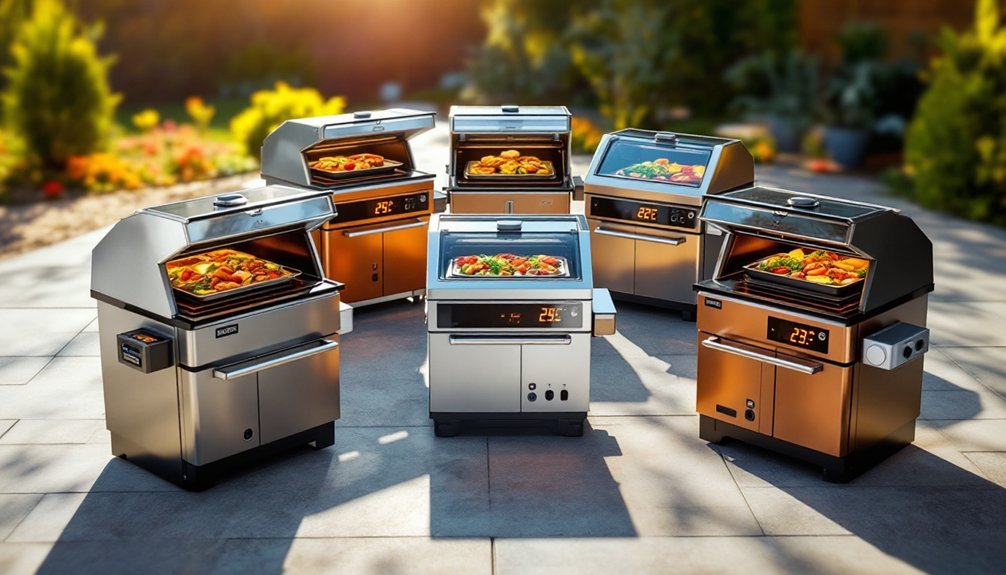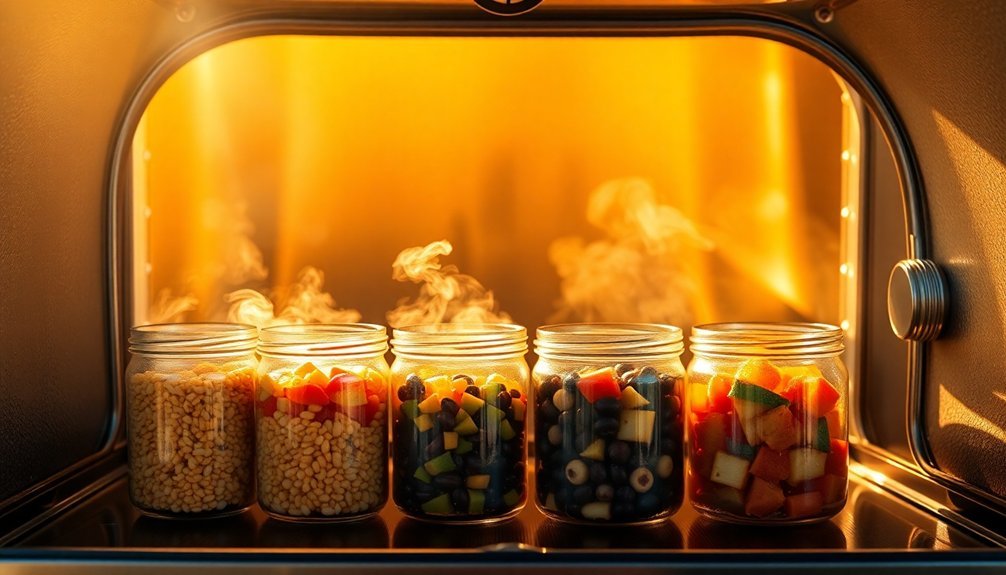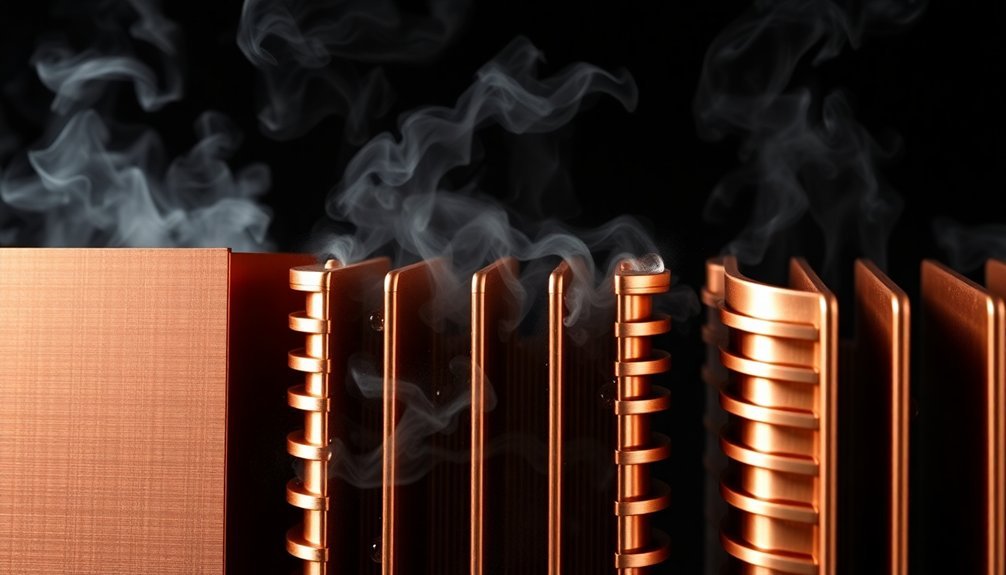You'll find that solar ovens have evolved considerably in 2025, with automatic temperature control transforming how you cook outdoors. Whether you're planning off-grid adventures or simply want to reduce your carbon footprint, these innovative cookers offer precision and reliability that wasn't possible just a few years ago. From compact portable models to hybrid designs, we've tested and ranked the top seven options that'll revolutionize your outdoor cooking experience.
Solar Oven Portable Outdoor Cooker (4.5L Capacity)
The MrMapMax Solar Oven packs an impressive 200-watt output into a portable 13.85-pound design, making it ideal for eco-conscious adventurers who need reliable off-grid cooking.
You'll appreciate its 4.5L capacity that feeds 2-3 people, reaching temperatures up to 550°F in just 20 minutes of sunlight. The vacuum tube cooking chamber maintains heat efficiently while keeping your food moist and tender. It even works on cloudy days by capturing UV light.
The handbag-style design with zipper closure makes transport easy, and it's safe enough for kids to use. While the thermometer accuracy varies, the oven's performance in camping, hiking, and emergency situations has earned it 4.5/5 stars from users.
Best For: Outdoor enthusiasts and campers seeking an eco-friendly, portable cooking solution that works without fuel or electricity while maintaining cooking performance similar to traditional methods.
Pros:
- Impressive maximum temperature of 550°F with efficient 20-minute cooking time
- Versatile usage in various weather conditions, including cloudy days
- Portable design with convenient carrying strap and 4.5L capacity suitable for small groups
Cons:
- Thermometer accuracy issues reported by some users
- Relatively heavy at 13.85 pounds compared to some portable stoves
- Limited by daylight hours and optimal sunlight conditions for best performance
GOSUN Fusion Solar Oven and Electric Hybrid Grill
Adventurous campers and off-grid enthusiasts will appreciate GOSUN Fusion's innovative hybrid approach to outdoor cooking. At just 16 pounds, this portable powerhouse reaches 550°F in full sunlight while consuming only 150 watts when using electric power.
You'll save significant time with its vacuum tube design that cooks meals in just 20 minutes, requiring no monitoring. Whether you're baking, roasting, or steaming, the 360° cooking chamber keeps food moist and flavorful. The included carrying case, scrub brush, and silicone molds make it perfect for outdoor adventures, while its durable stainless steel construction guarantees lasting performance.
Best For: Outdoor enthusiasts, campers, and eco-conscious cooks who want a versatile, portable cooking solution that can operate both on solar power and minimal electricity.
Pros:
- Innovative hybrid design combines solar and electric power for reliable cooking in any conditions
- Highly efficient vacuum tube technology cooks meals quickly while maintaining moisture and flavor
- Lightweight and portable at 16 pounds with included carrying case and accessories
Cons:
- Some quality control issues reported with scratches and improper fitting parts
- Longer cooking times of 2-3 hours when not in direct sunlight
- Higher price point compared to traditional portable grills or solar cookers
Premium Solar Oven, Portable Solar Cooker with Guide
Outdoor cooking enthusiasts seeking a versatile solar solution will appreciate this premium portable oven that reaches temperatures up to 212°F. The sturdy construction features reinforced foam, reflective metal panels, and a transparent PVC lid, making it ideal for cooking everything from cornbread to meats.
You'll find the mid-size interior accommodates a 5-quart Dutch oven, while support rods provide stability. While the cooker excels at reheating food in 30-40 minutes, expect longer cooking times of 1-6 hours for raw ingredients. For best results, use black cookware, elevate your pots, and reposition the oven to follow the sun's path.
Best For: Outdoor enthusiasts, campers, and emergency preparedness-minded individuals who want an eco-friendly cooking solution and don't mind longer cooking times.
Pros:
- Portable and lightweight design makes it easy to transport and store
- Versatile cooking capabilities for various foods from baked goods to meats
- Cost-effective and environmentally friendly cooking solution with no fuel needed
Cons:
- Long cooking times ranging from 1-6 hours for most dishes
- Requires frequent repositioning to follow the sun for optimal cooking
- Plastic cover can sag and durability issues with zippers and reflective material
Elite Gourmet French Door Convection Oven (ETO-4510M)
Serious home chefs seeking versatility will appreciate Elite Gourmet's ETO-4510M French door convection oven, a spacious 45L powerhouse that excels at multiple cooking functions. You'll fit up to 18 toast slices or two 14" pizzas on its four rack positions, while the rotisserie function handles a 7lb turkey.
Despite its elegant stainless steel design and convenient dual-door setup, you'll need to watch for temperature inconsistencies. The independent heating controls reach 450°F, but actual temperatures may vary. While the convection feature guarantees flaky crusts and tender meats, be cautious with the racks, as they can tip without full support.
Best For: Home cooks who need a versatile countertop oven with substantial capacity for multiple dishes and value the convenience of French doors and rotisserie capabilities.
Pros:
- Large 45L capacity accommodates multiple dishes, including 18 slices of toast or two 14" pizzas
- Versatile cooking functions including convection, rotisserie, baking, and broiling with dual-door design
- Independent temperature controls for top and bottom heating elements up to 450°F
Cons:
- Temperature accuracy issues with significant variances from set temperatures
- Safety concerns with unstable racks that can tip when pulled out
- Quality control problems including bending racks and missing rotisserie components
Nuwave Flex Precision Induction Cooktop
Temperature-conscious cooks will appreciate the Nuwave Flex Precision Induction Cooktop's 45 pre-programmed settings, ranging from 100°F to 500°F in precise 10-degree increments. You'll find three power settings at 600W, 900W, and 1300W, with the highest setting boiling water in just 90 seconds.
The 6.5" heating coil works best with smaller cookware, while the shatter-proof 10.25" ceramic glass surface guarantees safety. You'll need to take into account the unit's electromagnetic field within two feet and its short power cord when planning placement. While there's no off switch, the digital controls make temperature adjustments seamless during cooking.
Best For: Home cooks with limited counter space who want precise temperature control and primarily use smaller cookware for tasks like warming sauces, simmering soups, or cooking individual portions.
Pros:
- Exceptional temperature precision with 45 pre-programmed settings from 100°F to 500°F
- Compact and portable design makes it perfect for small kitchens or as a supplementary cooking surface
- Quick heating capability with three power settings, boiling water in as little as 90 seconds at highest setting
Cons:
- Limited cooking area with 6.5" heating coil restricts use to smaller pots and pans
- Short power cord and EMF emissions within two feet limit placement options
- Lacks an off switch and requires cool-down period before unplugging
All Season Solar Cooker (17) Camper
Solar cooking enthusiasts seeking versatility will find the All Season Solar Cooker (17) Camper a compelling choice for year-round meal preparation. This lightweight 4-pound cooker reaches temperatures up to 250 degrees and features articulating collector panels that maximize solar capture even in low-sun conditions.
You'll appreciate its generous 28-inch cooking area that accommodates large cookware up to turkey-roaster size. Made from food-grade polypropylene, it's both durable and waterproof. The cooker folds down to just an inch thick for convenient storage. While some users note it's slightly pricey and the assembly instructions could be clearer, its 4.4-star rating from 457 reviews confirms its reliable performance.
Best For: Solar cooking enthusiasts who want a portable, large-capacity cooker that works year-round and in variable sun conditions.
Pros:
- Large cooking capacity that fits multiple dishes or a turkey roaster
- Lightweight (4 lbs) and folds down to 1-inch thickness for easy storage
- Adjustable panels allow for effective cooking even in low-sun conditions
Cons:
- Assembly instructions could be clearer and more detailed
- Relatively high price point compared to other solar cookers
- Large size may make panel adjustments and transport more cumbersome
GOSUN Portable Solar Oven Kit for Outdoor Cooking
Adventure seekers and outdoor enthusiasts will love the GOSUN Portable Solar Oven Kit's quick 20-minute cooking capability. At just 2 pounds, this compact solar cooker is perfect for camping, beach trips, and outdoor adventures.
You'll appreciate the safety-first design featuring a vacuum cooking tube that prevents burns while effectively preparing your meals. The kit includes everything you need: frame brackets, vacuum tube, cooking tray, reflectors, cleaning brush, and lid. Setup is straightforward with five simple steps.
While it's ideal for cooking small portions, be aware that larger meals might require multiple batches. The 4.0-star rating reflects mixed user experiences, particularly regarding the lid and tray fit.
Best For: Solo travelers, couples, or small groups who enjoy outdoor activities and want a lightweight, eco-friendly cooking solution for preparing small meals during their adventures.
Pros:
- Lightweight and portable at only 2 pounds, making it perfect for on-the-go cooking
- Quick 20-minute cooking time with safe, burn-free operation
- Complete kit includes all necessary components for immediate use with simple setup
Cons:
- Limited capacity – only suitable for cooking 1-2 meals at a time
- Some users report issues with lid and cooking tray fit
- Dependent on sunny weather conditions for effective cooking
Factors to Consider When Choosing a Solar Oven With Automatic Temperature Control
When you're shopping for a solar oven with automatic temperature control, you'll need to evaluate several key technical features that affect cooking performance and reliability. Your primary considerations should include the oven's maximum temperature capabilities, the sophistication of its built-in thermostat, and how quickly the temperature control system responds to fluctuations. You'll also want to examine the heat distribution technology and any power requirements for the control mechanisms, as these factors directly impact cooking consistency and the oven's true portability.
Maximum Temperature Range Capabilities
Understanding the maximum temperature range of a solar oven is essential for matching your cooking needs. Top-performing models can reach impressive temperatures up to 550°F (288°C), giving you the flexibility to bake, roast, and cook various dishes just like a conventional oven.
When you're evaluating temperature capabilities, look for models that can maintain steady heat around 250°F (121°C) for slow cooking. You'll want to take into account how quickly you need your meals ready, as cooking times can range from 20 minutes to several hours depending on the oven's maximum temperature. Advanced models with vacuum insulation offer better heat retention, but remember that external factors like sunlight intensity and collector angle will affect performance. Pay attention to these specifications to guarantee you'll get consistent results for your intended cooking purposes.
Built-in Thermostat Features
A reliable built-in thermostat transforms your solar oven from a basic sun-powered box into a precision cooking instrument. These smart controls help maintain peak temperatures while preventing overheating, ensuring your food cooks evenly and stays moist.
You'll find that thermostats enable your solar oven to reach impressive temperatures up to 550°F, making it versatile enough for various cooking methods. The automatic regulation means you won't need to constantly monitor your meals – some dishes can be ready in just 20 minutes under ideal conditions.
Look for models with helpful indicator features that alert you when your oven reaches the desired temperature. This added convenience takes the guesswork out of solar cooking and helps you achieve consistent results every time you prepare meals using the sun's energy.
Temperature Control Response Time
How quickly your solar oven responds to temperature changes can make or break your outdoor cooking experience. High-quality solar ovens with advanced temperature control systems can rapidly adjust to fluctuating sunlight conditions, maintaining consistent heat for ideal cooking results.
Look for models with vacuum tube insulation and efficient heat retention capabilities, as they'll respond faster to temperature adjustments and keep your food cooking steadily. The best units can reach temperatures up to 550°F, delivering cooking times as quick as 20 minutes. You'll want to take into account how well the oven performs in cloudy conditions, too. Models that can effectively capture ultraviolet light will give you more reliable temperature control even when the sun isn't directly overhead. This responsiveness guarantees you won't need to constantly monitor your cooking progress.
Heat Distribution Technology
Beyond responsive temperature controls, proper heat distribution can make the difference between perfectly cooked meals and disappointing results. You'll want to look for solar ovens that incorporate vacuum insulation technology, which maintains consistent temperatures throughout the cooking chamber and eliminates cold spots.
The most effective models feature strategic reflective materials that maximize sunlight capture and distribute heat uniformly. Some advanced designs even include rotating reflectors or adjustable panels that track the sun's movement, ensuring ideal heat distribution throughout the day. When these technologies work together, you'll experience faster cooking times – some models can prepare meals in just 20 minutes under ideal conditions. By choosing a solar oven with superior heat distribution features, you'll achieve more reliable and even cooking results every time.
Power Source Requirements
Three primary power source considerations shape your choice of a solar oven with automatic temperature control. First, you'll need to evaluate the solar oven's energy output capacity, which typically ranges from 200 watts to 1.5 kilowatts, as this directly affects your cooking time and efficiency. Second, consider whether you'll be using the oven primarily in full sunlight, where temperatures can reach 550°F, or in varying weather conditions, as UV light penetration affects performance.
Finally, check if the model you're considering includes enhanced power-retention features like vacuum insulation and reflective surfaces. These elements are essential for maintaining consistent temperatures when sunlight isn't ideal. If you're planning to use your solar oven for outdoor activities, look for lightweight, portable models that can effectively capture and retain solar energy while on the move.
Weather Impact on Performance
Weather conditions directly influence your solar oven's cooking performance, making it essential to understand these factors before selecting a model with automatic temperature control.
While solar ovens can function effectively in cloudy or snowy conditions by capturing ultraviolet light, you'll get the best results in direct sunlight where temperatures can reach up to 550°F. Your cooking times will vary from 20 minutes to several hours depending on weather conditions and food type. To maximize efficiency, you'll need to adjust your oven's position throughout the day to track the sun's movement.
Look for models with superior insulation, particularly those featuring vacuum tube technology, as they'll maintain consistent temperatures despite weather variations. This becomes especially important when you're cooking in less-than-ideal conditions, ensuring your solar oven remains reliable year-round.
Cooking Chamber Size
Selecting the right cooking chamber size stands as a critical factor when investing in a solar oven with automatic temperature control. You'll find options ranging from 4.5 to 45 liters, and choosing the appropriate size depends on your typical cooking needs.
When you're cooking for a family or hosting gatherings, you'll want a larger chamber that can accommodate multiple dishes or bigger cookware. For solo cooking or couples, a smaller chamber will suffice. Consider how the chamber's insulation affects heat retention – better-insulated models maintain consistent temperatures more effectively.
Look for a cooking space that's versatile enough to fit different pot sizes and shapes. This flexibility lets you experiment with various cooking styles and recipes. Remember, proper sizing guarantees your food heats evenly and efficiently.
Construction Material Durability
When evaluating solar ovens with automatic temperature control, durability of construction materials should be your top priority. Look for models that feature stainless steel components, as they'll resist corrosion and handle high temperatures effectively over time.
You'll want to check for reinforced materials throughout the oven's construction, particularly in the reflective panels and insulation layers. Solar ovens with vacuum tube designs offer superior protection against environmental damage while maintaining excellent heat retention. Consider the quality of zippers and seals, as these components directly impact the oven's performance and longevity.
While durability is essential, don't overlook portability. The best solar ovens balance sturdy construction with manageable weight, using lightweight yet robust materials that won't compromise structural integrity during transport and regular use.
Frequently Asked Questions
Can Solar Ovens Work Effectively on Cloudy or Partly Cloudy Days?
You'll get reduced performance on cloudy days, but solar ovens can still work if there's enough indirect sunlight. They'll cook slower and reach lower temperatures, so you should plan for extended cooking times.
How Long Does It Take for a Solar Oven to Reach Cooking Temperature?
You'll typically wait 30-45 minutes for your solar oven to reach cooking temperature (300-350°F) on a sunny day. The time varies based on sunlight intensity, outdoor temperature, and your oven's design.
What Happens if the Automatic Temperature Control System Malfunctions During Cooking?
If your temperature control system fails, you'll risk burning or undercooking your food. It's best to monitor cooking manually, remove the food immediately, and check if your backup safety features are working properly.
Are Solar Ovens Safe to Leave Unattended While Cooking?
You shouldn't leave solar ovens unattended while cooking. Even with temperature controls, weather changes can affect performance, and you'll need to monitor food safety, adjust positioning, and check for proper cooking throughout the process.
Can Solar Ovens Be Used to Cook Frozen Foods Directly?
You can cook frozen foods in a solar oven, but you'll get better results if you thaw them first. Direct cooking from frozen takes longer and may lead to uneven heating and food safety concerns.





Leave a Reply